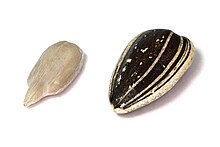**Production and Usage**:
– Global sunflower seed production in 2020 reached 50 million tonnes.
– Russia and Ukraine were the top producers, contributing 53% of the world’s total production.
– Other significant producers included Argentina, China, and Romania.
– Sunflower seeds are classified by husk pattern for commercial purposes.
– Sunflower seeds are rich in protein, fiber, vitamins, and minerals.
– They are commonly consumed as snacks, in recipes, or as garnishes.
– Sunflower seeds can be sold in-shell, dehulled kernels, or sprouted for salads.
– The seeds can be processed by drying, roasting, or flavoring for different consumption preferences.
– Sunflower seeds are popular in various regions and used in products like bread, candy, and sunflower butter.
**Nutrition and Health Benefits**:
– In a 100-gram serving, dried whole sunflower seeds provide 584 kilocalories.
– Sunflower seeds are rich in protein, dietary fiber, B vitamins, vitamin E, and minerals like magnesium, manganese, and zinc.
– They contain monounsaturated and polyunsaturated fats, including linoleic acid.
– Sunflower seeds contain phytosterols that may help lower blood cholesterol levels.
– Regular consumption of sunflower seeds can contribute to improved heart health.
– Sunflower seeds and pistachios are effective in lowering cholesterol levels.
– Including sunflower seeds in a balanced diet can be beneficial for cholesterol management.
**Sunflower Oil**:
– Sunflower oil is a popular culinary oil worldwide.
– It is extracted by applying high pressure to sunflower seeds.
– The protein-rich cake left after extraction is used as livestock feed.
– Original sunflower oil is high in polyunsaturated fatty acids and low in saturated fats.
– Different hybrids have been developed to modify the fatty acid profile for various uses.
– Sunflower oil is a good source of vitamin E and unsaturated fats.
– Regular consumption of sunflower oil may have positive effects on heart health.
**Sunflower Hulls and Shells**:
– Sunflower hulls decompose slowly and can be burned as biomass fuel.
– Cultivated sunflower hulls contain compounds toxic to many plants.
– Sunflower shells can be utilized for energy production through pyrolysis.
– They have specific allelopathic properties and limited use due to toxicity.
– Sunflower shells show promise for sustainable energy generation.
– Understanding sunflower allelopathy aids in sustainable weed management strategies.
**Research and Allelopathic Properties**:
– Research has focused on sunflower seed allelopathy and its impact on weed control.
– Different sunflower genotypes and organs exhibit varying allelopathic potentials.
– Sunflower biomass partitioning influences its allelopathic activity.
– Exploring sunflower seed allelopathy contributes to understanding its ecological role.
– Sunflowers exhibit allelopathic effects that can inhibit weed growth, showing potential for sustainable weed control strategies.
A sunflower seed is a seed from a sunflower (Helianthus annuus). There are three types of commonly used sunflower seeds: linoleic (most common), high oleic, and sunflower oil seeds. Each variety has its own unique levels of monounsaturated, saturated, and polyunsaturated fats. The information in this article refers mainly to the linoleic variety.


For commercial purposes, sunflower seeds are usually classified by the pattern on their husks. If the husk is solid black, the seeds are called black oil sunflower seeds. The crops may be referred to as oilseed sunflower crops. These seeds are usually pressed to extract their oil. Striped sunflower seeds are primarily eaten as a snack food; as a result, they may be called confectionery sunflower seeds.
The term "sunflower seed" is actually a misnomer when applied to the seed in its pericarp (hull). Botanically speaking, it is a cypsela. When dehulled, the edible remainder is called the sunflower kernel or heart.
